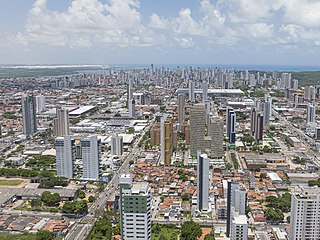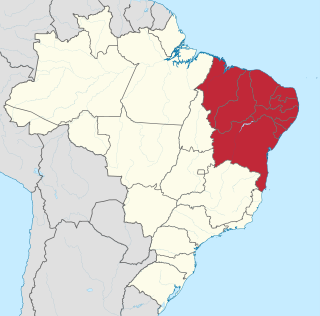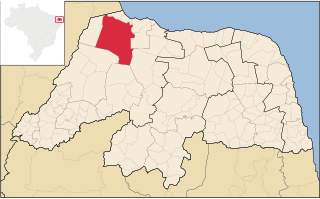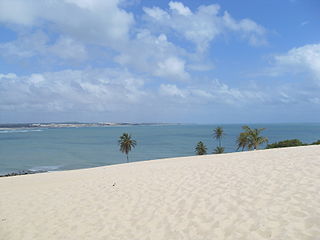
Ceará is one of the 26 states of Brazil, located in the northeastern part of the country, on the Atlantic coast. It is the eighth-largest Brazilian State by population and the 17th by area. It is also one of the main tourist destinations in Brazil. The state capital is the city of Fortaleza, the country's fourth most populous city. The state has 4.3% of the Brazilian population and produces 2.1% of the Brazilian GDP.

Rio Grande do Norte is one of the states of Brazil. It is located in the northeastern region of the country, forming the northeasternmost tip of the South American continent. The name literally translates as "Great Northern River", referring to the mouth of the Potenji River.

Natal is the capital and largest city of the state of Rio Grande do Norte, located in northeastern Brazil. According to IBGE's 2022 estimate, the city had a total population of 751,300, making it the 24th largest city in the country. Natal is a major tourist destination and an exporting hub of crustaceans, carnauba wax and fruits, mostly melon, sugar apple, cashew and papaya. Natal is Brazil's closest city to Africa and Europe, its Greater Natal International Airport connects the city with many Brazilian destinations and also operates some international flights. The city was one of the host cities of the 2014 FIFA World Cup.

The Northeast Region of Brazil is one of the five official and political regions of the country according to the Brazilian Institute of Geography and Statistics. Of Brazil's twenty-six states, it comprises nine: Maranhão, Piauí, Ceará, Rio Grande do Norte, Paraíba, Pernambuco, Alagoas, Sergipe and Bahia, along with the Fernando de Noronha archipelago.

Parnaíba is a city in the Brazilian state of Piauí. Having a population of over 169,000 inhabitants according to IBGE's 2024 estimates, it is the second most populous city in the state, after the capital Teresina. It is one of the four coastal municipalities in Piauí, all of which make up the city's metropolitan area.

Mossoró is the second most populous city in the state of Rio Grande do Norte, Brazil, and also the largest municipality of that state. It is equidistant from Natal, the state capital of Rio Grande do Norte, and from Fortaleza, the capital of the state of Ceará. It is also in the heart of Brazil's salt production area. Situated in the Oeste Potiguar mesoregion, Mossoró is the country's largest land-based petroleum producer.

The agriculture of Brazil is historically one of the principal bases of Brazil's economy. As of 2024 the country is the second biggest grain exporter in the world, with 19% of the international market share, and the fourth overall grain producer. Brazil is the world's largest exporter of many popular agriculture commodities like coffee, soybeans, organic honey, beef, poultry, cane sugar, açai berry, orange juice, yerba mate, cellulose, tobacco, and the second biggest exporter of maize, pork, cotton, and ethanol. The country also has a significant presence as producer and exporter of rice, wheat, eggs, refined sugar, cocoa, beans, nuts, cassava, sisal fiber, and diverse fruits and vegetables.

Touros is a municipality in Rio Grande do Norte, Brazil. It is known as "Brazil's Corner" because it is located at the northeast corner of the country, being the closest South American city to Africa. Touros has many fish, and there is a nearby seawater basin in the ocean formed by banks of coral.

Cajueiro da Praia is one of the four coastal cities of Piauí, Brazil.

The coastline of Brazil measures 7,491 km, making it the 16th longest national coastline in the world. The coastline touches exclusively the Atlantic Ocean. Brazil's coastline has many geographical features such as islands, reefs, bays, and its 2,095 beaches.

The Natal Dunes State Park "Journalist Luiz Maria Alves", or simply the Dunes Park is a state park in the state of Rio Grande do Norte in the Northeast Region of Brazil. It protects an area of dunes and native vegetation along the coastal highway.
"World's largest cashew tree" may refer to one of two trees in Brazil:

Events in the year 1953 in Brazil.

Events in the year 1988 in Brazil.
The Miss Brazil World 2001 pageant took place on September 28, 2001. It was 16th edition of the contest. Each state and the Federal District competed for their state and went to compete for the title of the Brazilian Crown for Miss World. The winner entered Miss World 2001. This year was the first time that Miss Brazil World was separated from the main pageant, Miss Brazil, for only 1 year. Joyce Yara Silva Aguiar of São Paulo ended being the winner at the end of the contest and also the first black woman to be Miss Brazil World. This contest was held separate from Miss Brazil 2001 and was apart from the latter for only a year before rejoining with the main contest the following year.
The Miss Brazil World 1996 pageant took place on October 11, 1996. Each state and the Federal District competed for the title of the Brazilian Crown for Miss World. The winner entered Miss World 1996. Anuska Prado of Espírito Santo ended being the winner at the end of the contest.
Miss Brazil CNB 2018 was the 29th edition of the Miss Brazil CNB pageant and the 4th under CNB Miss Brazil, held at the Hotel do Bosque in Angra dos Reis, Brazil, on August 11, 2018.
Miss Brazil World 2011 was the 22nd edition of the Miss Brazil World pageant and 6th under MMB Productions & Events. The contest took place on August 13, 2011. Each state, the Federal District and various Insular Regions competed for the title. Kamilla Salgado of Pará crowned Juceila Bueno of Rio Grande do Sul at the end of the contest. Bueno represented Brazil at Miss World 2011. The contest was held at the Hotel do Frade in Angra dos Reis, Rio de Janeiro, Brazil.

André de Albuquerque Square, also popularly known as Red Square, is located in the Cidade Alta neighborhood, in Natal, capital of the state of Rio Grande do Norte. The square, named after the revolutionary André de Albuquerque Maranhão, who fought on the side of the Pernambuco rebels, marks the geodesic point of the city and also its zero milestone.
















